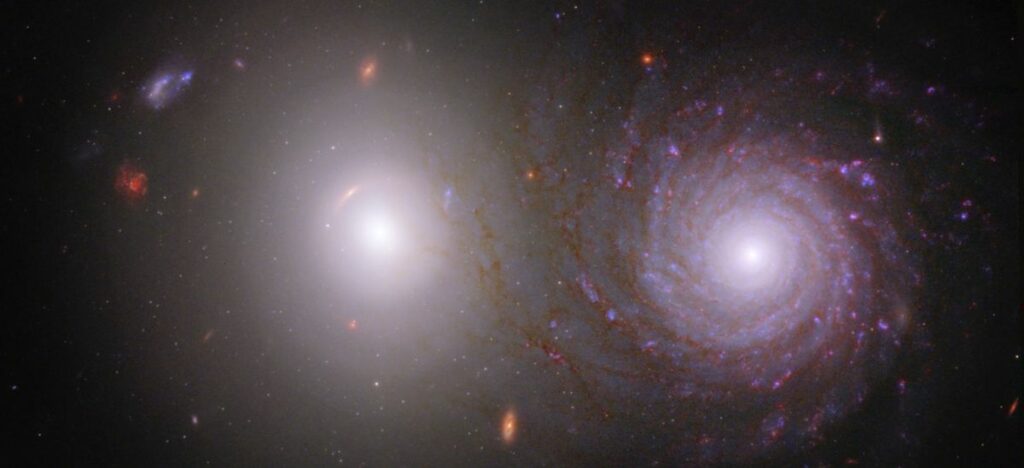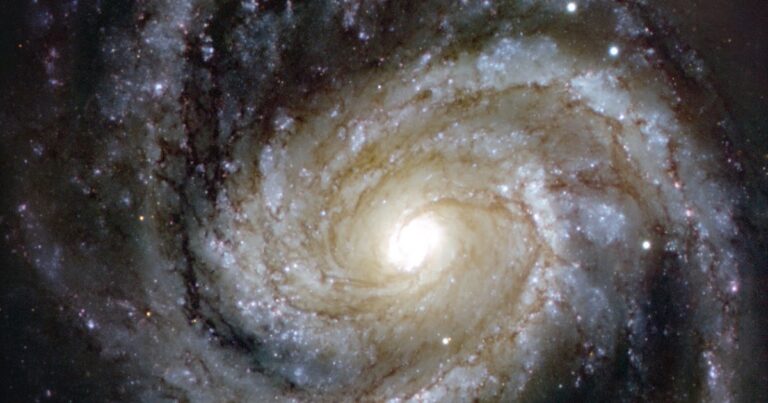Why does the captivating spiral structure of the Milky Way seem to be an unusual phenomenon?
Galaxies that were originally intended to have spiral structures may have undergone a transformation, becoming irregularly shaped ellipticals with clumpy features.
If you were to ascend from Earth to a vantage point where you could observe the entire Milky Way, our home galaxy would present itself as a rotating pinwheel. Comprising approximately 100 billion stars scattered across a span of about 100,000 light-years, accompanied by vast quantities of gas and dust, these galactic elements collectively engage in a celestial dance within a stellar disk. This disk spills into four prominent spiral arms emanating from the galaxy’s brilliantly radiant center, the abode of a supermassive black hole.
While we commonly associate our galaxy with its spiral structure, the exact number of its galactic arms remains a subject of ongoing debate among astronomers. Yet, a longstanding mystery has intrigued scientists: the apparent scarcity of spiral galaxies like ours in our densely populated cosmic neighborhood. Instead, the expansive supergalactic plane encompassing the Milky Way—stretching over 1.4 billion light-years in width—is predominantly populated by clumpy, somewhat rounded galaxies known as ellipticals.
A newly developed supercomputer simulation, tracing the 13.8 billion-year evolution of the universe, proposes an explanation for this scarcity. The simulation suggests that frequent, naturally occurring interactions among galaxies in the supergalactic plane play a pivotal role in smoothing out potential spiral arms, ultimately giving rise to the elliptical galaxies prevalent in our cosmic vicinity.
In spiral galaxies like the Milky Way, stars orbit their galactic centers in predominantly circular paths. However, when two galaxies of comparable mass approach each other closely, these orderly motions become disordered.
Astrophysicist Till Sawala, a co-author of a study on these findings from the University of Helsinki in Finland, explained, “The stellar orbits become reshuffled or randomized. This removes any ordered features, such as the appearance of a stellar disk, and therefore also removes the appearance of spiral arms.”
The repercussions of large galaxies merging are multifaceted. Beyond randomizing the orbits of numerous stars, these interactions can sometimes trigger a starburst—a phenomenon where a multitude of new stars are born.
Furthermore, the supermassive black holes residing at the centers of most large galaxies can become activated during mergers. Sawala noted, “This can change, and generally reduces the amount of new stars that the new galaxy can grow after the merger,” resulting in a more elliptical shape.
While our Milky Way has expanded over time by absorbing smaller galaxies, known as dwarf galaxies, their diminutive sizes have not significantly influenced the galaxy’s overall structure. However, the projected head-on collision between the Milky Way and the Andromeda galaxy, anticipated to occur four billion years from now, may finally impact our galaxy’s structure. Andromeda, with a mass similar to or possibly exceeding our own, presents the potential for a transformative encounter.

Regarding the possibility of a spiral galaxy that has lost its arms and transformed into an elliptical regaining its original configuration, Sawala suggests that this is likely not achievable.
While galaxies with sufficient gas reservoirs can generate new stars, potentially forming spiral arms, this restorative process does not apply to elliptical galaxies, as they generally lack significant amounts of gas.
“An elliptical galaxy is unlikely to revert to a disk galaxy,” explained Sawala. “The transition from disk galaxies, representing a state of order, to elliptical galaxies, representing a state of disorder, is generally irreversible.”
Sawala’s team is currently focused on refining their simulations to enhance accuracy, enabling a more detailed comparison between our understanding of fundamental physical processes and telescopic observations of the local universe.
“This effort either allows us to refine our comprehension of observed phenomena or, ideally, identify gaps or errors in our knowledge,” Sawala remarked. “In our recent publication, the simulation aligned precisely with the observed phenomena.”
“On a personal note, I am optimistic that in future endeavors, we may uncover genuine anomalies!”
This research was described in a paper published Monday (Nov. 20) in the journal Nature Astronomy.
This article is republished from SpaceCom under a Creative Commons license. Read the original article.
Do not forget to share your opinion with us to provide you with the best posts !




0 Comments